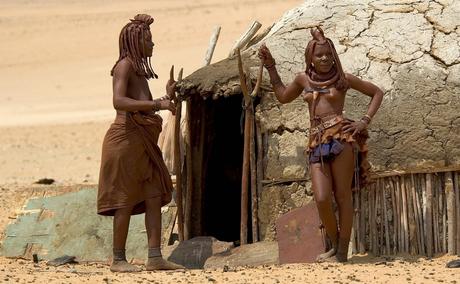
The Himba is the famous tribe of 'red people' in northern Namibia. Women paint themselves twice a day with red clay mixed with butter. They wear short skirts made of goat skins and long red clay covered plaits of hair ending with tassells.At first it can seem that there are only women in the Himba tribe. Almost all of them are traditionally dressed, proud and beautiful. In contrast, the men usually have adopted western clothes and you don't get to see them much in the villages anyway, because they are often far away with their herds, or (unfortunately) in the pub. They are getting fond of alcohol (just as, for example, the Surma in the Omo Valley) which is now getting in by the newly repaired road. The Himba are a tribe of nomadic pastoralists who inhabit the Kaokoland area of Namibia. The Himba are actually descendants of a group of Herero herders who fled into the remote north-west after been displaced by the Nama. The Himba have clung to their traditions and the beautiful Himba women are noted for their intricate hairstyles which and traditional jewellery.
As Himba men and woman wear few clothes apart from a loin cloth or goat skinned mini-skirt, they rub their bodies with red ochre and fat to protect themselves from the sun and also gives their appearance a rich red colour. The Himba jewellery is made from iron or shell, and due to their intricate designs have become very popular amongst western tourists. Himba homesteads are cone shaped structures made from palm leaves, mud and cattle dung. During the course of a year the family will move from one home to another in search of grazing for the animals. For this reason it is important not to take anything from a Himba hut even if it appears abandoned.
The traditional village at Puros or the luxury Epupa Lodge are both good places to visit if you want to learn more about the Himba way of life. The Himba live in homesteads of cone shaped structures made from mud, mopane trees and cattle dung with a central kraal and a sacred line leading from the chief's hut to the main kraal gate. In the centre of this is the "okuruwo," or holy fire. Kept continuously alight, the holy fire represents the ancestors of the villagers, who acts as intermediaries to the Himba's god, Mukuru. This is where all male circumcision and teeth are removed before puberty to get them ready for marriage. The Himba are polygamous with the average Himba man being husband to more than 1 wife at a time. The more cattle the man has, the more wives he can have. Throughout the course of a year being semi Nomadic the family will move from one homestead to another in search of grazing for the animals.

